Corporate Accounting and Business Advisory
VerifiedAdded on 2023/01/16
|16
|4130
|57
AI Summary
This document provides an in-depth analysis of the business plan pitch, sales and marketing strategy, operational strategy, and financial plan of Coral Kiss, a company offering natural and organic skin care products. It discusses the target market, customer needs, social impact, relevant megatrends, and similar successful campaigns. The document also covers the operational structure, outsourcing strategy, and operational risks faced by the company. Additionally, it provides insights into the financial plan, including profit and loss statements, capital requirements, and valuation.
Contribute Materials
Your contribution can guide someone’s learning journey. Share your
documents today.
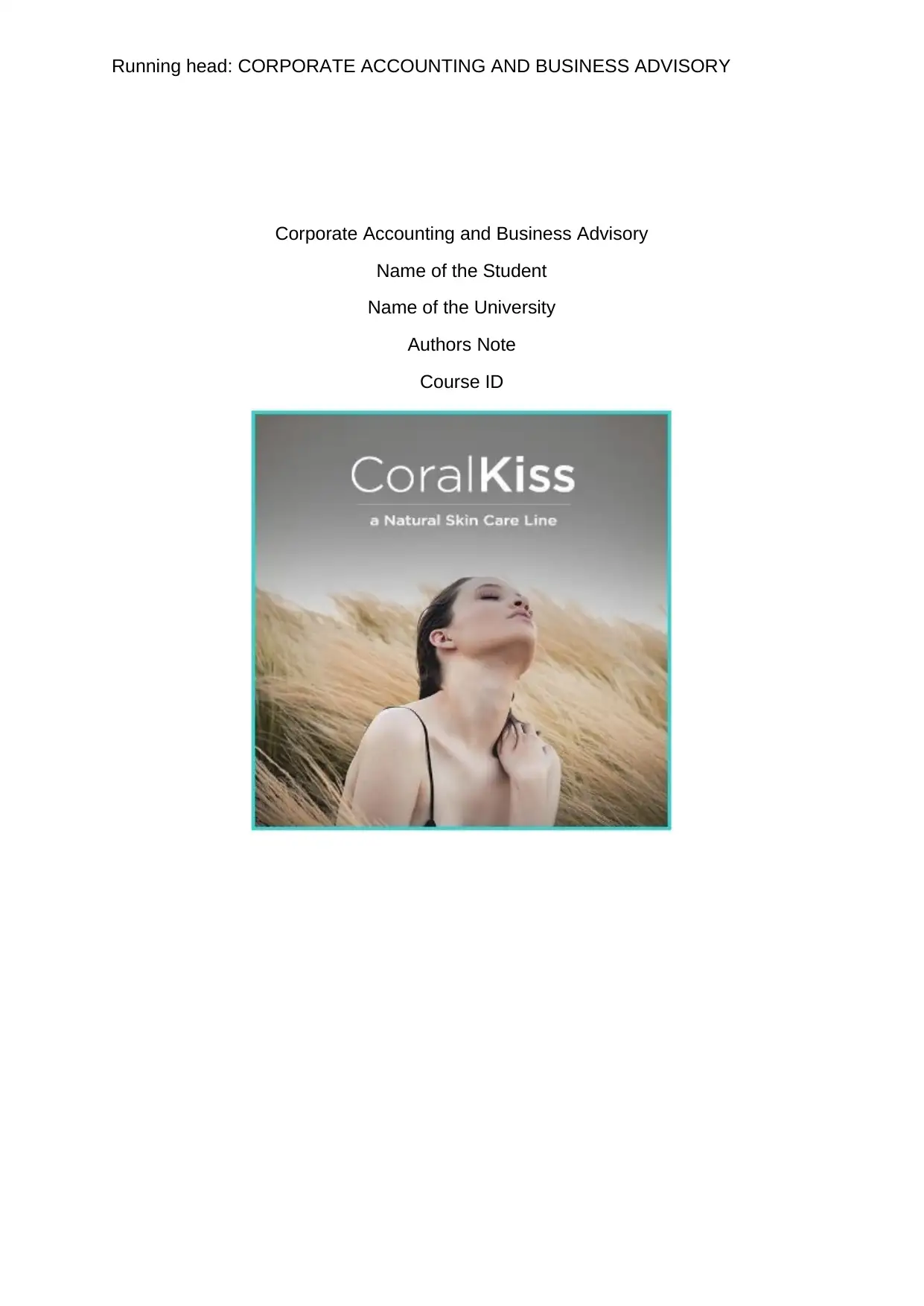
Running head: CORPORATE ACCOUNTING AND BUSINESS ADVISORY
Corporate Accounting and Business Advisory
Name of the Student
Name of the University
Authors Note
Course ID
Corporate Accounting and Business Advisory
Name of the Student
Name of the University
Authors Note
Course ID
Secure Best Marks with AI Grader
Need help grading? Try our AI Grader for instant feedback on your assignments.
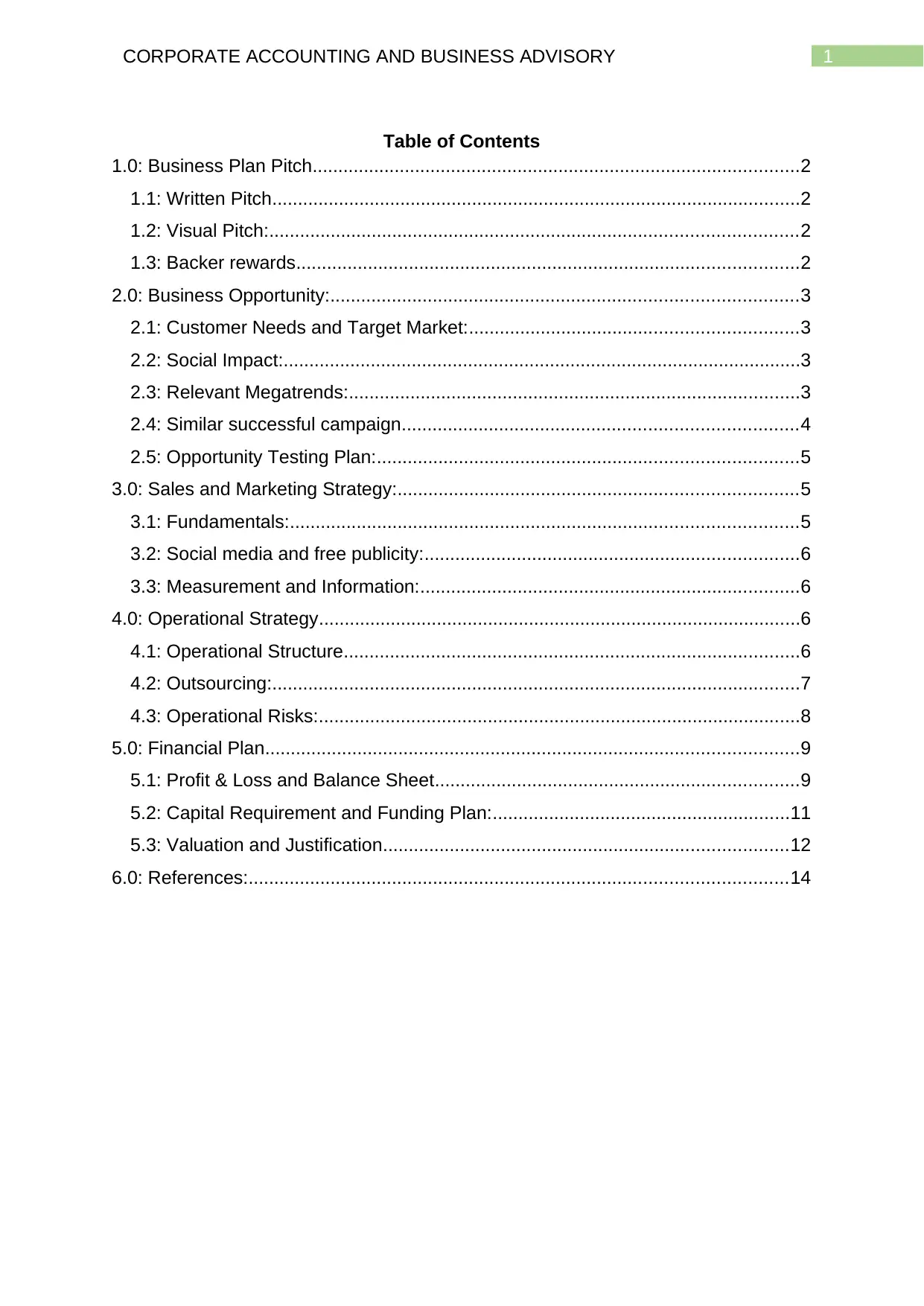
1CORPORATE ACCOUNTING AND BUSINESS ADVISORY
Table of Contents
1.0: Business Plan Pitch...............................................................................................2
1.1: Written Pitch.......................................................................................................2
1.2: Visual Pitch:.......................................................................................................2
1.3: Backer rewards..................................................................................................2
2.0: Business Opportunity:...........................................................................................3
2.1: Customer Needs and Target Market:................................................................3
2.2: Social Impact:.....................................................................................................3
2.3: Relevant Megatrends:........................................................................................3
2.4: Similar successful campaign.............................................................................4
2.5: Opportunity Testing Plan:..................................................................................5
3.0: Sales and Marketing Strategy:..............................................................................5
3.1: Fundamentals:...................................................................................................5
3.2: Social media and free publicity:.........................................................................6
3.3: Measurement and Information:..........................................................................6
4.0: Operational Strategy..............................................................................................6
4.1: Operational Structure.........................................................................................6
4.2: Outsourcing:.......................................................................................................7
4.3: Operational Risks:..............................................................................................8
5.0: Financial Plan........................................................................................................9
5.1: Profit & Loss and Balance Sheet.......................................................................9
5.2: Capital Requirement and Funding Plan:..........................................................11
5.3: Valuation and Justification...............................................................................12
6.0: References:.........................................................................................................14
Table of Contents
1.0: Business Plan Pitch...............................................................................................2
1.1: Written Pitch.......................................................................................................2
1.2: Visual Pitch:.......................................................................................................2
1.3: Backer rewards..................................................................................................2
2.0: Business Opportunity:...........................................................................................3
2.1: Customer Needs and Target Market:................................................................3
2.2: Social Impact:.....................................................................................................3
2.3: Relevant Megatrends:........................................................................................3
2.4: Similar successful campaign.............................................................................4
2.5: Opportunity Testing Plan:..................................................................................5
3.0: Sales and Marketing Strategy:..............................................................................5
3.1: Fundamentals:...................................................................................................5
3.2: Social media and free publicity:.........................................................................6
3.3: Measurement and Information:..........................................................................6
4.0: Operational Strategy..............................................................................................6
4.1: Operational Structure.........................................................................................6
4.2: Outsourcing:.......................................................................................................7
4.3: Operational Risks:..............................................................................................8
5.0: Financial Plan........................................................................................................9
5.1: Profit & Loss and Balance Sheet.......................................................................9
5.2: Capital Requirement and Funding Plan:..........................................................11
5.3: Valuation and Justification...............................................................................12
6.0: References:.........................................................................................................14
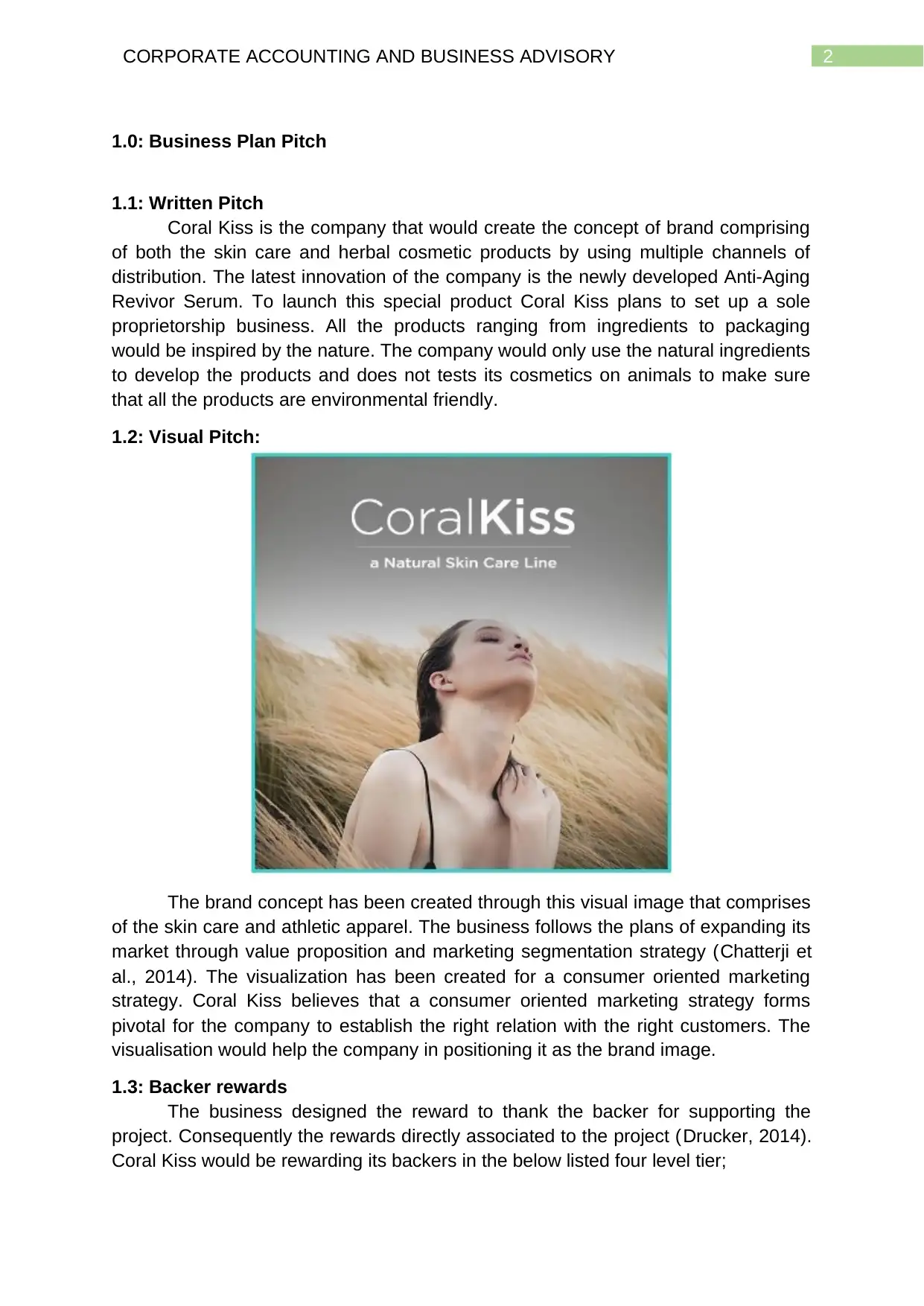
2CORPORATE ACCOUNTING AND BUSINESS ADVISORY
1.0: Business Plan Pitch
1.1: Written Pitch
Coral Kiss is the company that would create the concept of brand comprising
of both the skin care and herbal cosmetic products by using multiple channels of
distribution. The latest innovation of the company is the newly developed Anti-Aging
Revivor Serum. To launch this special product Coral Kiss plans to set up a sole
proprietorship business. All the products ranging from ingredients to packaging
would be inspired by the nature. The company would only use the natural ingredients
to develop the products and does not tests its cosmetics on animals to make sure
that all the products are environmental friendly.
1.2: Visual Pitch:
The brand concept has been created through this visual image that comprises
of the skin care and athletic apparel. The business follows the plans of expanding its
market through value proposition and marketing segmentation strategy (Chatterji et
al., 2014). The visualization has been created for a consumer oriented marketing
strategy. Coral Kiss believes that a consumer oriented marketing strategy forms
pivotal for the company to establish the right relation with the right customers. The
visualisation would help the company in positioning it as the brand image.
1.3: Backer rewards
The business designed the reward to thank the backer for supporting the
project. Consequently the rewards directly associated to the project (Drucker, 2014).
Coral Kiss would be rewarding its backers in the below listed four level tier;
1.0: Business Plan Pitch
1.1: Written Pitch
Coral Kiss is the company that would create the concept of brand comprising
of both the skin care and herbal cosmetic products by using multiple channels of
distribution. The latest innovation of the company is the newly developed Anti-Aging
Revivor Serum. To launch this special product Coral Kiss plans to set up a sole
proprietorship business. All the products ranging from ingredients to packaging
would be inspired by the nature. The company would only use the natural ingredients
to develop the products and does not tests its cosmetics on animals to make sure
that all the products are environmental friendly.
1.2: Visual Pitch:
The brand concept has been created through this visual image that comprises
of the skin care and athletic apparel. The business follows the plans of expanding its
market through value proposition and marketing segmentation strategy (Chatterji et
al., 2014). The visualization has been created for a consumer oriented marketing
strategy. Coral Kiss believes that a consumer oriented marketing strategy forms
pivotal for the company to establish the right relation with the right customers. The
visualisation would help the company in positioning it as the brand image.
1.3: Backer rewards
The business designed the reward to thank the backer for supporting the
project. Consequently the rewards directly associated to the project (Drucker, 2014).
Coral Kiss would be rewarding its backers in the below listed four level tier;
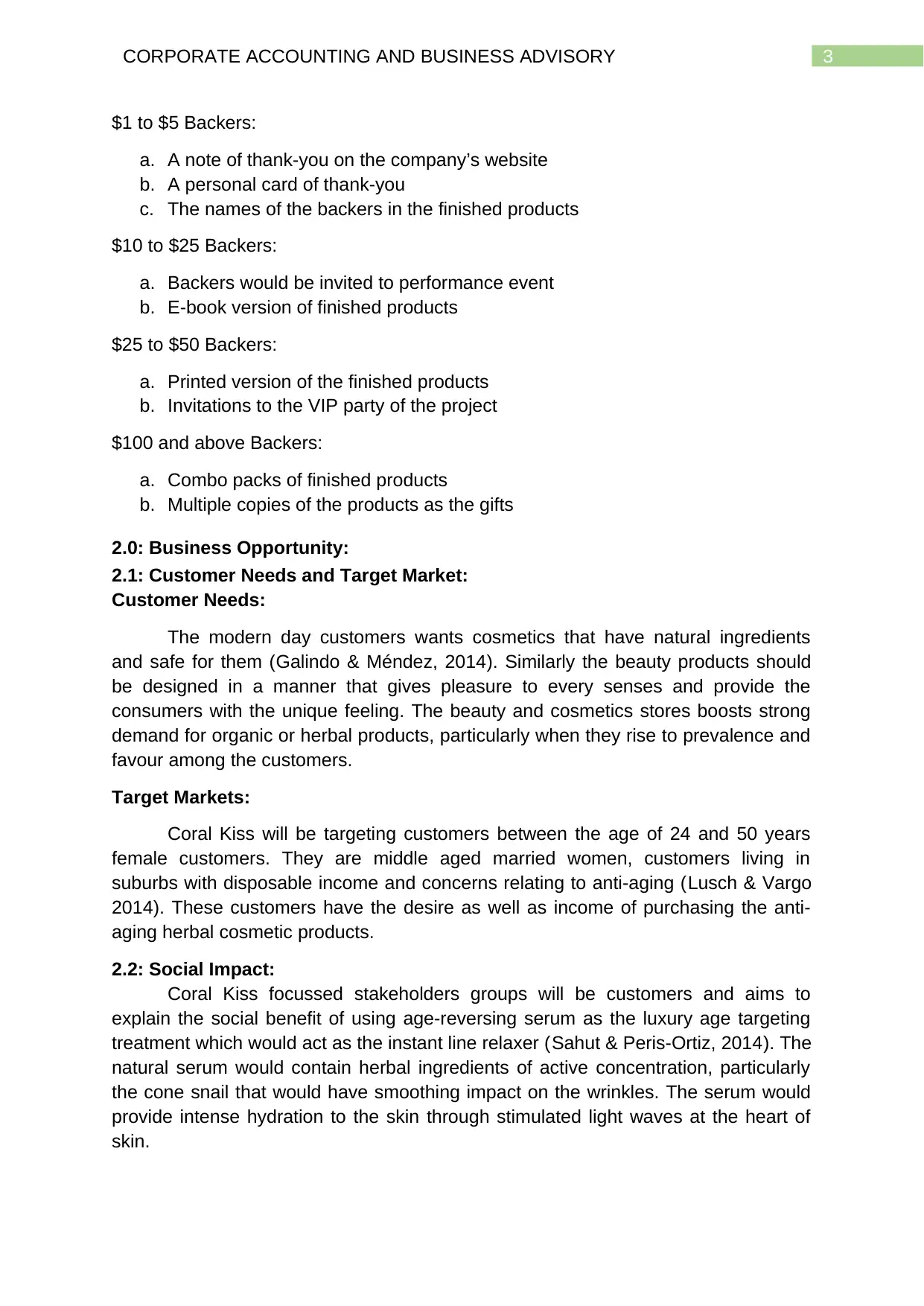
3CORPORATE ACCOUNTING AND BUSINESS ADVISORY
$1 to $5 Backers:
a. A note of thank-you on the company’s website
b. A personal card of thank-you
c. The names of the backers in the finished products
$10 to $25 Backers:
a. Backers would be invited to performance event
b. E-book version of finished products
$25 to $50 Backers:
a. Printed version of the finished products
b. Invitations to the VIP party of the project
$100 and above Backers:
a. Combo packs of finished products
b. Multiple copies of the products as the gifts
2.0: Business Opportunity:
2.1: Customer Needs and Target Market:
Customer Needs:
The modern day customers wants cosmetics that have natural ingredients
and safe for them (Galindo & Méndez, 2014). Similarly the beauty products should
be designed in a manner that gives pleasure to every senses and provide the
consumers with the unique feeling. The beauty and cosmetics stores boosts strong
demand for organic or herbal products, particularly when they rise to prevalence and
favour among the customers.
Target Markets:
Coral Kiss will be targeting customers between the age of 24 and 50 years
female customers. They are middle aged married women, customers living in
suburbs with disposable income and concerns relating to anti-aging (Lusch & Vargo
2014). These customers have the desire as well as income of purchasing the anti-
aging herbal cosmetic products.
2.2: Social Impact:
Coral Kiss focussed stakeholders groups will be customers and aims to
explain the social benefit of using age-reversing serum as the luxury age targeting
treatment which would act as the instant line relaxer (Sahut & Peris-Ortiz, 2014). The
natural serum would contain herbal ingredients of active concentration, particularly
the cone snail that would have smoothing impact on the wrinkles. The serum would
provide intense hydration to the skin through stimulated light waves at the heart of
skin.
$1 to $5 Backers:
a. A note of thank-you on the company’s website
b. A personal card of thank-you
c. The names of the backers in the finished products
$10 to $25 Backers:
a. Backers would be invited to performance event
b. E-book version of finished products
$25 to $50 Backers:
a. Printed version of the finished products
b. Invitations to the VIP party of the project
$100 and above Backers:
a. Combo packs of finished products
b. Multiple copies of the products as the gifts
2.0: Business Opportunity:
2.1: Customer Needs and Target Market:
Customer Needs:
The modern day customers wants cosmetics that have natural ingredients
and safe for them (Galindo & Méndez, 2014). Similarly the beauty products should
be designed in a manner that gives pleasure to every senses and provide the
consumers with the unique feeling. The beauty and cosmetics stores boosts strong
demand for organic or herbal products, particularly when they rise to prevalence and
favour among the customers.
Target Markets:
Coral Kiss will be targeting customers between the age of 24 and 50 years
female customers. They are middle aged married women, customers living in
suburbs with disposable income and concerns relating to anti-aging (Lusch & Vargo
2014). These customers have the desire as well as income of purchasing the anti-
aging herbal cosmetic products.
2.2: Social Impact:
Coral Kiss focussed stakeholders groups will be customers and aims to
explain the social benefit of using age-reversing serum as the luxury age targeting
treatment which would act as the instant line relaxer (Sahut & Peris-Ortiz, 2014). The
natural serum would contain herbal ingredients of active concentration, particularly
the cone snail that would have smoothing impact on the wrinkles. The serum would
provide intense hydration to the skin through stimulated light waves at the heart of
skin.
Secure Best Marks with AI Grader
Need help grading? Try our AI Grader for instant feedback on your assignments.
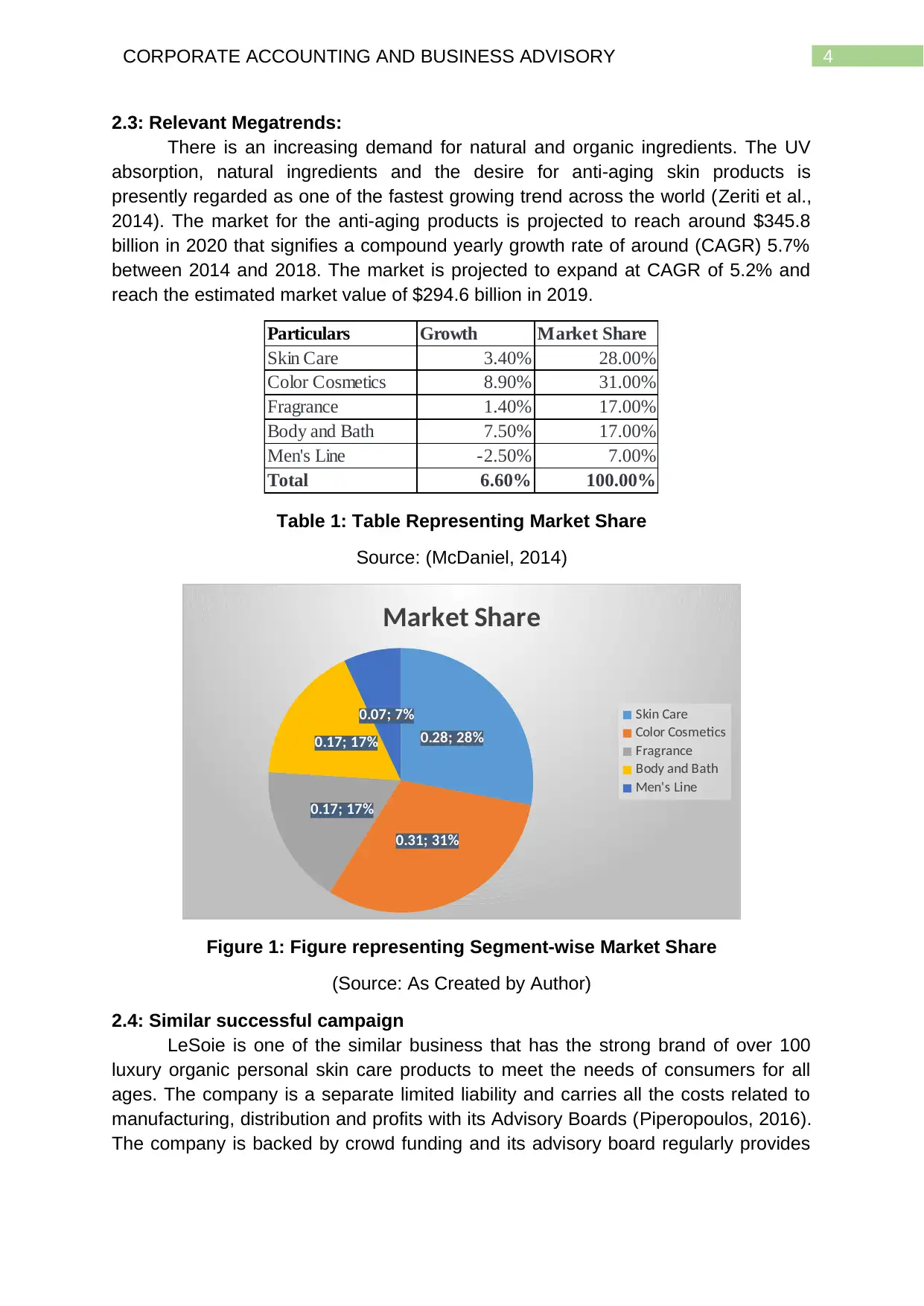
4CORPORATE ACCOUNTING AND BUSINESS ADVISORY
2.3: Relevant Megatrends:
There is an increasing demand for natural and organic ingredients. The UV
absorption, natural ingredients and the desire for anti-aging skin products is
presently regarded as one of the fastest growing trend across the world (Zeriti et al.,
2014). The market for the anti-aging products is projected to reach around $345.8
billion in 2020 that signifies a compound yearly growth rate of around (CAGR) 5.7%
between 2014 and 2018. The market is projected to expand at CAGR of 5.2% and
reach the estimated market value of $294.6 billion in 2019.
Particulars Growth Market Share
Skin Care 3.40% 28.00%
Color Cosmetics 8.90% 31.00%
Fragrance 1.40% 17.00%
Body and Bath 7.50% 17.00%
Men's Line -2.50% 7.00%
Total 6.60% 100.00%
Table 1: Table Representing Market Share
Source: (McDaniel, 2014)
0.28; 28%
0.31; 31%
0.17; 17%
0.17; 17%
0.07; 7%
Market Share
Skin Care
Color Cosmetics
Fragrance
Body and Bath
Men's Line
Figure 1: Figure representing Segment-wise Market Share
(Source: As Created by Author)
2.4: Similar successful campaign
LeSoie is one of the similar business that has the strong brand of over 100
luxury organic personal skin care products to meet the needs of consumers for all
ages. The company is a separate limited liability and carries all the costs related to
manufacturing, distribution and profits with its Advisory Boards (Piperopoulos, 2016).
The company is backed by crowd funding and its advisory board regularly provides
2.3: Relevant Megatrends:
There is an increasing demand for natural and organic ingredients. The UV
absorption, natural ingredients and the desire for anti-aging skin products is
presently regarded as one of the fastest growing trend across the world (Zeriti et al.,
2014). The market for the anti-aging products is projected to reach around $345.8
billion in 2020 that signifies a compound yearly growth rate of around (CAGR) 5.7%
between 2014 and 2018. The market is projected to expand at CAGR of 5.2% and
reach the estimated market value of $294.6 billion in 2019.
Particulars Growth Market Share
Skin Care 3.40% 28.00%
Color Cosmetics 8.90% 31.00%
Fragrance 1.40% 17.00%
Body and Bath 7.50% 17.00%
Men's Line -2.50% 7.00%
Total 6.60% 100.00%
Table 1: Table Representing Market Share
Source: (McDaniel, 2014)
0.28; 28%
0.31; 31%
0.17; 17%
0.17; 17%
0.07; 7%
Market Share
Skin Care
Color Cosmetics
Fragrance
Body and Bath
Men's Line
Figure 1: Figure representing Segment-wise Market Share
(Source: As Created by Author)
2.4: Similar successful campaign
LeSoie is one of the similar business that has the strong brand of over 100
luxury organic personal skin care products to meet the needs of consumers for all
ages. The company is a separate limited liability and carries all the costs related to
manufacturing, distribution and profits with its Advisory Boards (Piperopoulos, 2016).
The company is backed by crowd funding and its advisory board regularly provides
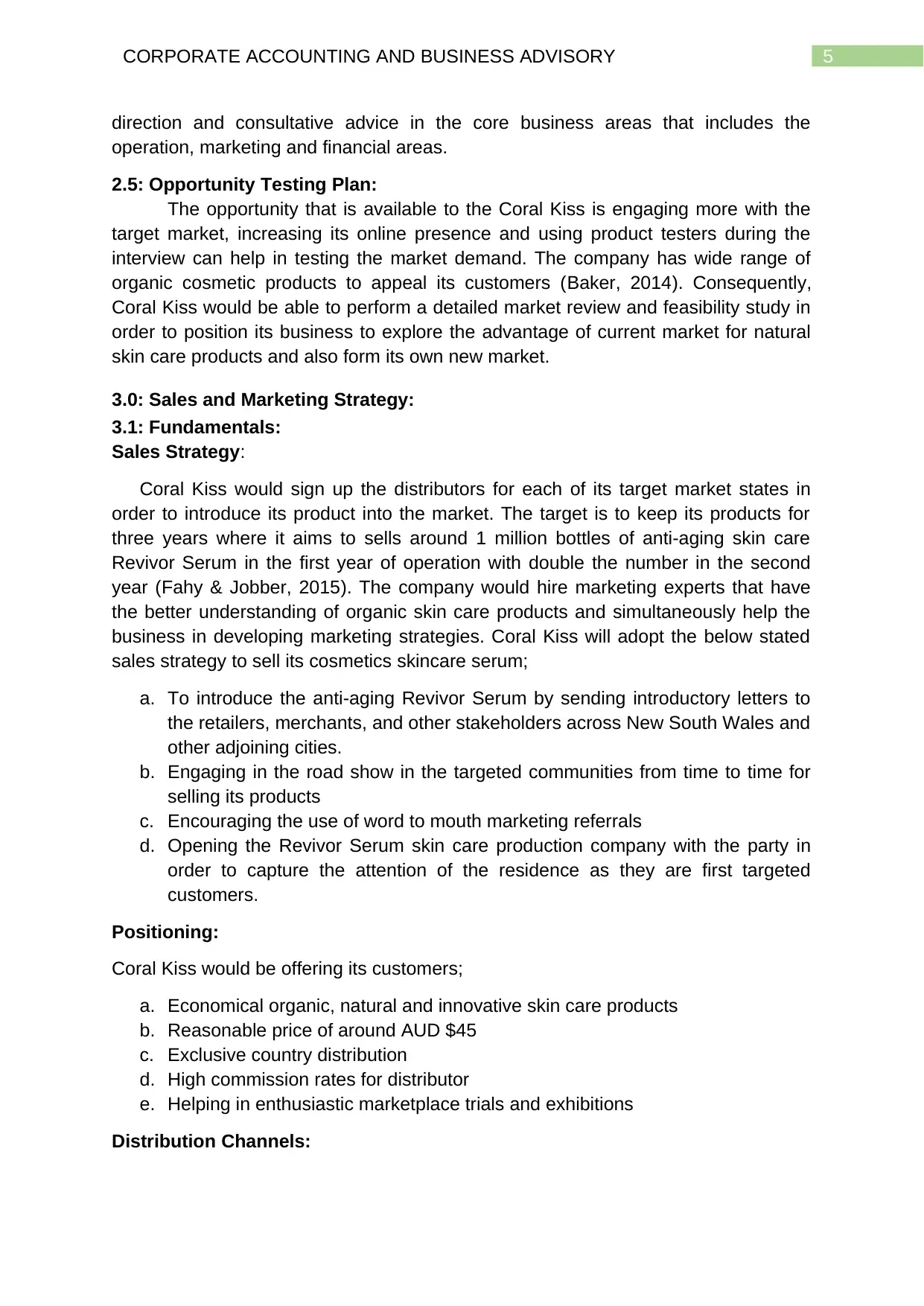
5CORPORATE ACCOUNTING AND BUSINESS ADVISORY
direction and consultative advice in the core business areas that includes the
operation, marketing and financial areas.
2.5: Opportunity Testing Plan:
The opportunity that is available to the Coral Kiss is engaging more with the
target market, increasing its online presence and using product testers during the
interview can help in testing the market demand. The company has wide range of
organic cosmetic products to appeal its customers (Baker, 2014). Consequently,
Coral Kiss would be able to perform a detailed market review and feasibility study in
order to position its business to explore the advantage of current market for natural
skin care products and also form its own new market.
3.0: Sales and Marketing Strategy:
3.1: Fundamentals:
Sales Strategy:
Coral Kiss would sign up the distributors for each of its target market states in
order to introduce its product into the market. The target is to keep its products for
three years where it aims to sells around 1 million bottles of anti-aging skin care
Revivor Serum in the first year of operation with double the number in the second
year (Fahy & Jobber, 2015). The company would hire marketing experts that have
the better understanding of organic skin care products and simultaneously help the
business in developing marketing strategies. Coral Kiss will adopt the below stated
sales strategy to sell its cosmetics skincare serum;
a. To introduce the anti-aging Revivor Serum by sending introductory letters to
the retailers, merchants, and other stakeholders across New South Wales and
other adjoining cities.
b. Engaging in the road show in the targeted communities from time to time for
selling its products
c. Encouraging the use of word to mouth marketing referrals
d. Opening the Revivor Serum skin care production company with the party in
order to capture the attention of the residence as they are first targeted
customers.
Positioning:
Coral Kiss would be offering its customers;
a. Economical organic, natural and innovative skin care products
b. Reasonable price of around AUD $45
c. Exclusive country distribution
d. High commission rates for distributor
e. Helping in enthusiastic marketplace trials and exhibitions
Distribution Channels:
direction and consultative advice in the core business areas that includes the
operation, marketing and financial areas.
2.5: Opportunity Testing Plan:
The opportunity that is available to the Coral Kiss is engaging more with the
target market, increasing its online presence and using product testers during the
interview can help in testing the market demand. The company has wide range of
organic cosmetic products to appeal its customers (Baker, 2014). Consequently,
Coral Kiss would be able to perform a detailed market review and feasibility study in
order to position its business to explore the advantage of current market for natural
skin care products and also form its own new market.
3.0: Sales and Marketing Strategy:
3.1: Fundamentals:
Sales Strategy:
Coral Kiss would sign up the distributors for each of its target market states in
order to introduce its product into the market. The target is to keep its products for
three years where it aims to sells around 1 million bottles of anti-aging skin care
Revivor Serum in the first year of operation with double the number in the second
year (Fahy & Jobber, 2015). The company would hire marketing experts that have
the better understanding of organic skin care products and simultaneously help the
business in developing marketing strategies. Coral Kiss will adopt the below stated
sales strategy to sell its cosmetics skincare serum;
a. To introduce the anti-aging Revivor Serum by sending introductory letters to
the retailers, merchants, and other stakeholders across New South Wales and
other adjoining cities.
b. Engaging in the road show in the targeted communities from time to time for
selling its products
c. Encouraging the use of word to mouth marketing referrals
d. Opening the Revivor Serum skin care production company with the party in
order to capture the attention of the residence as they are first targeted
customers.
Positioning:
Coral Kiss would be offering its customers;
a. Economical organic, natural and innovative skin care products
b. Reasonable price of around AUD $45
c. Exclusive country distribution
d. High commission rates for distributor
e. Helping in enthusiastic marketplace trials and exhibitions
Distribution Channels:
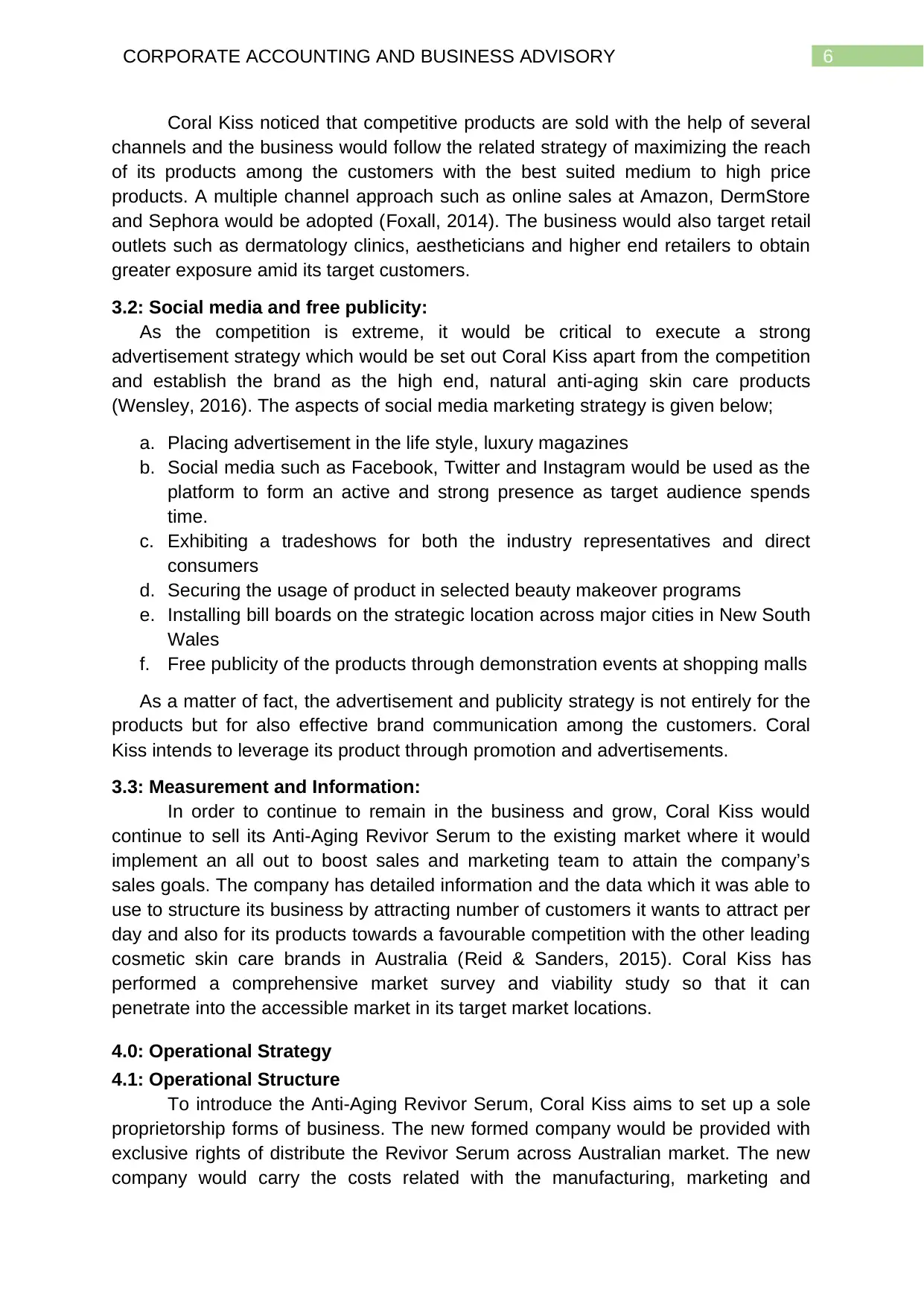
6CORPORATE ACCOUNTING AND BUSINESS ADVISORY
Coral Kiss noticed that competitive products are sold with the help of several
channels and the business would follow the related strategy of maximizing the reach
of its products among the customers with the best suited medium to high price
products. A multiple channel approach such as online sales at Amazon, DermStore
and Sephora would be adopted (Foxall, 2014). The business would also target retail
outlets such as dermatology clinics, aestheticians and higher end retailers to obtain
greater exposure amid its target customers.
3.2: Social media and free publicity:
As the competition is extreme, it would be critical to execute a strong
advertisement strategy which would be set out Coral Kiss apart from the competition
and establish the brand as the high end, natural anti-aging skin care products
(Wensley, 2016). The aspects of social media marketing strategy is given below;
a. Placing advertisement in the life style, luxury magazines
b. Social media such as Facebook, Twitter and Instagram would be used as the
platform to form an active and strong presence as target audience spends
time.
c. Exhibiting a tradeshows for both the industry representatives and direct
consumers
d. Securing the usage of product in selected beauty makeover programs
e. Installing bill boards on the strategic location across major cities in New South
Wales
f. Free publicity of the products through demonstration events at shopping malls
As a matter of fact, the advertisement and publicity strategy is not entirely for the
products but for also effective brand communication among the customers. Coral
Kiss intends to leverage its product through promotion and advertisements.
3.3: Measurement and Information:
In order to continue to remain in the business and grow, Coral Kiss would
continue to sell its Anti-Aging Revivor Serum to the existing market where it would
implement an all out to boost sales and marketing team to attain the company’s
sales goals. The company has detailed information and the data which it was able to
use to structure its business by attracting number of customers it wants to attract per
day and also for its products towards a favourable competition with the other leading
cosmetic skin care brands in Australia (Reid & Sanders, 2015). Coral Kiss has
performed a comprehensive market survey and viability study so that it can
penetrate into the accessible market in its target market locations.
4.0: Operational Strategy
4.1: Operational Structure
To introduce the Anti-Aging Revivor Serum, Coral Kiss aims to set up a sole
proprietorship forms of business. The new formed company would be provided with
exclusive rights of distribute the Revivor Serum across Australian market. The new
company would carry the costs related with the manufacturing, marketing and
Coral Kiss noticed that competitive products are sold with the help of several
channels and the business would follow the related strategy of maximizing the reach
of its products among the customers with the best suited medium to high price
products. A multiple channel approach such as online sales at Amazon, DermStore
and Sephora would be adopted (Foxall, 2014). The business would also target retail
outlets such as dermatology clinics, aestheticians and higher end retailers to obtain
greater exposure amid its target customers.
3.2: Social media and free publicity:
As the competition is extreme, it would be critical to execute a strong
advertisement strategy which would be set out Coral Kiss apart from the competition
and establish the brand as the high end, natural anti-aging skin care products
(Wensley, 2016). The aspects of social media marketing strategy is given below;
a. Placing advertisement in the life style, luxury magazines
b. Social media such as Facebook, Twitter and Instagram would be used as the
platform to form an active and strong presence as target audience spends
time.
c. Exhibiting a tradeshows for both the industry representatives and direct
consumers
d. Securing the usage of product in selected beauty makeover programs
e. Installing bill boards on the strategic location across major cities in New South
Wales
f. Free publicity of the products through demonstration events at shopping malls
As a matter of fact, the advertisement and publicity strategy is not entirely for the
products but for also effective brand communication among the customers. Coral
Kiss intends to leverage its product through promotion and advertisements.
3.3: Measurement and Information:
In order to continue to remain in the business and grow, Coral Kiss would
continue to sell its Anti-Aging Revivor Serum to the existing market where it would
implement an all out to boost sales and marketing team to attain the company’s
sales goals. The company has detailed information and the data which it was able to
use to structure its business by attracting number of customers it wants to attract per
day and also for its products towards a favourable competition with the other leading
cosmetic skin care brands in Australia (Reid & Sanders, 2015). Coral Kiss has
performed a comprehensive market survey and viability study so that it can
penetrate into the accessible market in its target market locations.
4.0: Operational Strategy
4.1: Operational Structure
To introduce the Anti-Aging Revivor Serum, Coral Kiss aims to set up a sole
proprietorship forms of business. The new formed company would be provided with
exclusive rights of distribute the Revivor Serum across Australian market. The new
company would carry the costs related with the manufacturing, marketing and
Paraphrase This Document
Need a fresh take? Get an instant paraphrase of this document with our AI Paraphraser
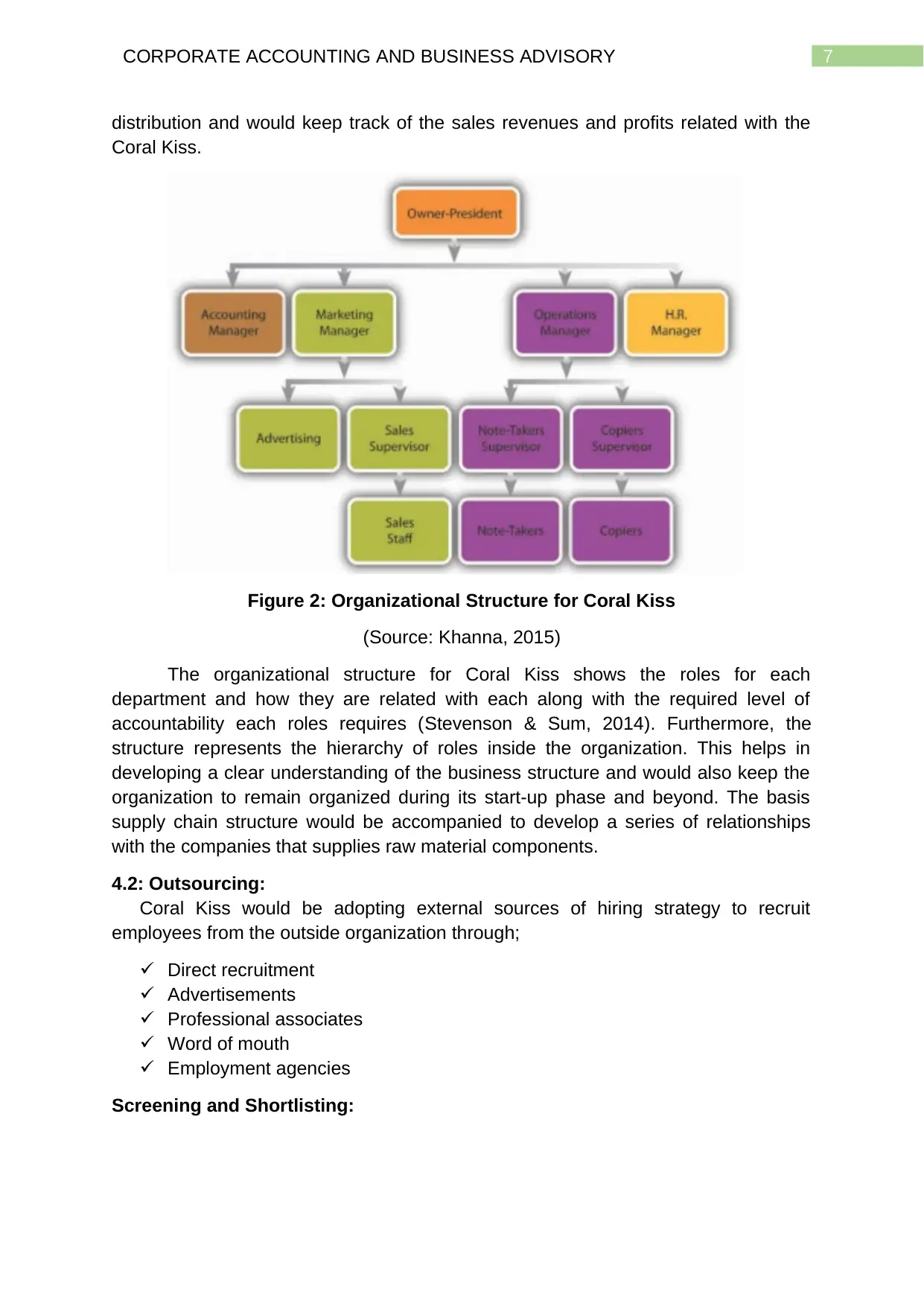
7CORPORATE ACCOUNTING AND BUSINESS ADVISORY
distribution and would keep track of the sales revenues and profits related with the
Coral Kiss.
Figure 2: Organizational Structure for Coral Kiss
(Source: Khanna, 2015)
The organizational structure for Coral Kiss shows the roles for each
department and how they are related with each along with the required level of
accountability each roles requires (Stevenson & Sum, 2014). Furthermore, the
structure represents the hierarchy of roles inside the organization. This helps in
developing a clear understanding of the business structure and would also keep the
organization to remain organized during its start-up phase and beyond. The basis
supply chain structure would be accompanied to develop a series of relationships
with the companies that supplies raw material components.
4.2: Outsourcing:
Coral Kiss would be adopting external sources of hiring strategy to recruit
employees from the outside organization through;
Direct recruitment
Advertisements
Professional associates
Word of mouth
Employment agencies
Screening and Shortlisting:
distribution and would keep track of the sales revenues and profits related with the
Coral Kiss.
Figure 2: Organizational Structure for Coral Kiss
(Source: Khanna, 2015)
The organizational structure for Coral Kiss shows the roles for each
department and how they are related with each along with the required level of
accountability each roles requires (Stevenson & Sum, 2014). Furthermore, the
structure represents the hierarchy of roles inside the organization. This helps in
developing a clear understanding of the business structure and would also keep the
organization to remain organized during its start-up phase and beyond. The basis
supply chain structure would be accompanied to develop a series of relationships
with the companies that supplies raw material components.
4.2: Outsourcing:
Coral Kiss would be adopting external sources of hiring strategy to recruit
employees from the outside organization through;
Direct recruitment
Advertisements
Professional associates
Word of mouth
Employment agencies
Screening and Shortlisting:
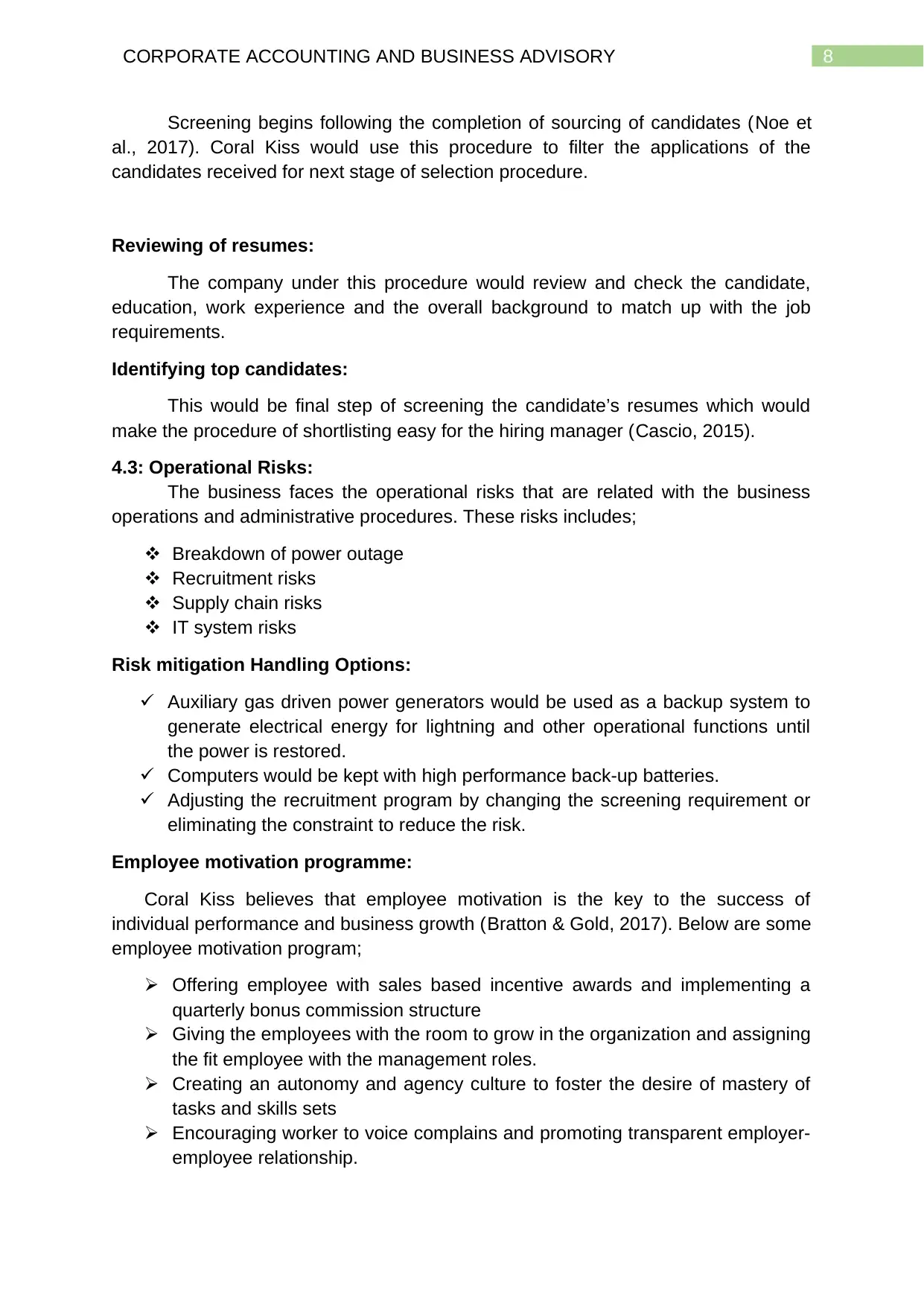
8CORPORATE ACCOUNTING AND BUSINESS ADVISORY
Screening begins following the completion of sourcing of candidates (Noe et
al., 2017). Coral Kiss would use this procedure to filter the applications of the
candidates received for next stage of selection procedure.
Reviewing of resumes:
The company under this procedure would review and check the candidate,
education, work experience and the overall background to match up with the job
requirements.
Identifying top candidates:
This would be final step of screening the candidate’s resumes which would
make the procedure of shortlisting easy for the hiring manager (Cascio, 2015).
4.3: Operational Risks:
The business faces the operational risks that are related with the business
operations and administrative procedures. These risks includes;
Breakdown of power outage
Recruitment risks
Supply chain risks
IT system risks
Risk mitigation Handling Options:
Auxiliary gas driven power generators would be used as a backup system to
generate electrical energy for lightning and other operational functions until
the power is restored.
Computers would be kept with high performance back-up batteries.
Adjusting the recruitment program by changing the screening requirement or
eliminating the constraint to reduce the risk.
Employee motivation programme:
Coral Kiss believes that employee motivation is the key to the success of
individual performance and business growth (Bratton & Gold, 2017). Below are some
employee motivation program;
Offering employee with sales based incentive awards and implementing a
quarterly bonus commission structure
Giving the employees with the room to grow in the organization and assigning
the fit employee with the management roles.
Creating an autonomy and agency culture to foster the desire of mastery of
tasks and skills sets
Encouraging worker to voice complains and promoting transparent employer-
employee relationship.
Screening begins following the completion of sourcing of candidates (Noe et
al., 2017). Coral Kiss would use this procedure to filter the applications of the
candidates received for next stage of selection procedure.
Reviewing of resumes:
The company under this procedure would review and check the candidate,
education, work experience and the overall background to match up with the job
requirements.
Identifying top candidates:
This would be final step of screening the candidate’s resumes which would
make the procedure of shortlisting easy for the hiring manager (Cascio, 2015).
4.3: Operational Risks:
The business faces the operational risks that are related with the business
operations and administrative procedures. These risks includes;
Breakdown of power outage
Recruitment risks
Supply chain risks
IT system risks
Risk mitigation Handling Options:
Auxiliary gas driven power generators would be used as a backup system to
generate electrical energy for lightning and other operational functions until
the power is restored.
Computers would be kept with high performance back-up batteries.
Adjusting the recruitment program by changing the screening requirement or
eliminating the constraint to reduce the risk.
Employee motivation programme:
Coral Kiss believes that employee motivation is the key to the success of
individual performance and business growth (Bratton & Gold, 2017). Below are some
employee motivation program;
Offering employee with sales based incentive awards and implementing a
quarterly bonus commission structure
Giving the employees with the room to grow in the organization and assigning
the fit employee with the management roles.
Creating an autonomy and agency culture to foster the desire of mastery of
tasks and skills sets
Encouraging worker to voice complains and promoting transparent employer-
employee relationship.
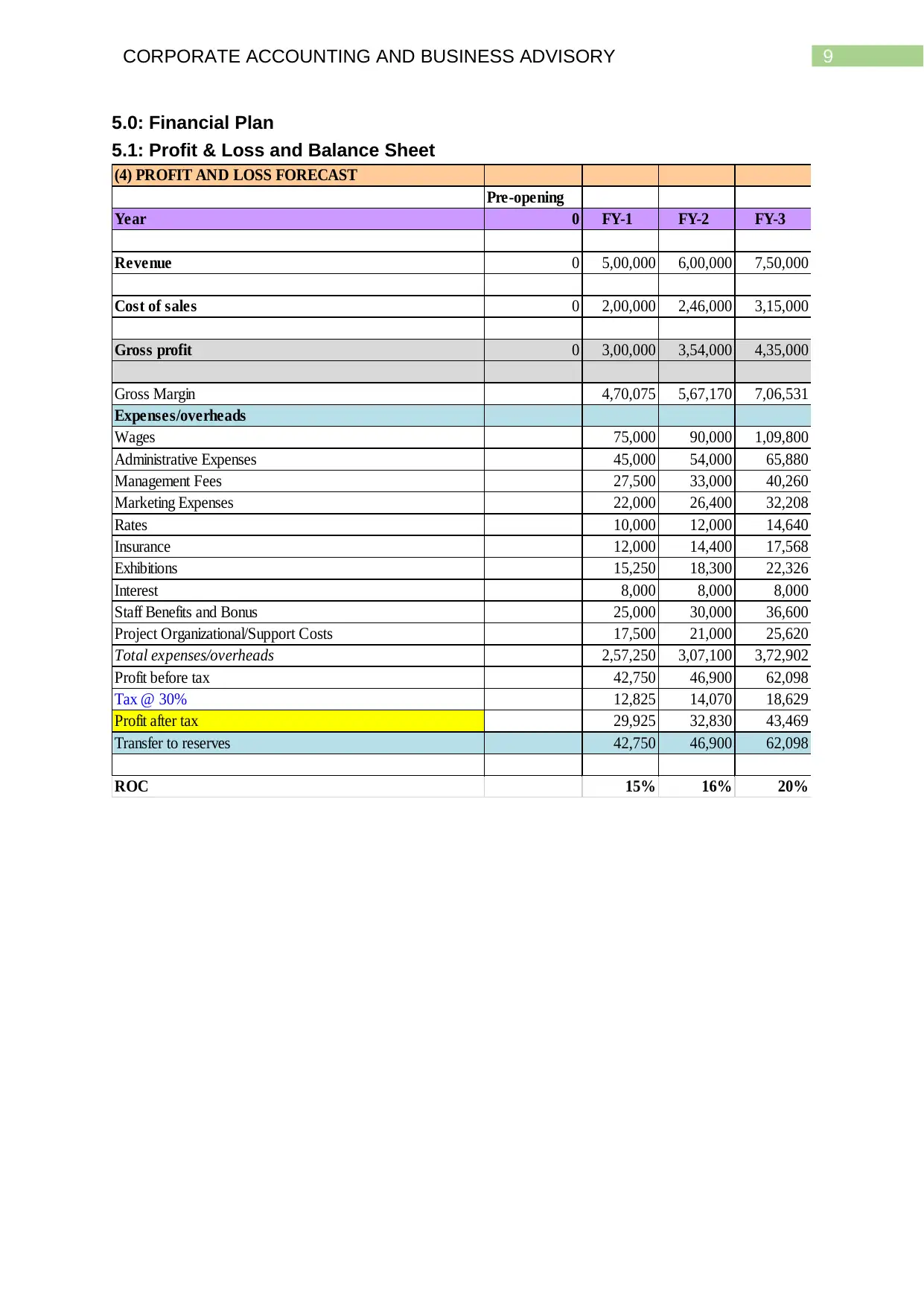
9CORPORATE ACCOUNTING AND BUSINESS ADVISORY
5.0: Financial Plan
5.1: Profit & Loss and Balance Sheet
(4) PROFIT AND LOSS FORECAST
Pre-opening
Year 0 FY-1 FY-2 FY-3
Revenue 0 5,00,000 6,00,000 7,50,000
Cost of sales 0 2,00,000 2,46,000 3,15,000
Gross profit 0 3,00,000 3,54,000 4,35,000
Gross Margin 4,70,075 5,67,170 7,06,531
Expenses/overheads
Wages 75,000 90,000 1,09,800
Administrative Expenses 45,000 54,000 65,880
Management Fees 27,500 33,000 40,260
Marketing Expenses 22,000 26,400 32,208
Rates 10,000 12,000 14,640
Insurance 12,000 14,400 17,568
Exhibitions 15,250 18,300 22,326
Interest 8,000 8,000 8,000
Staff Benefits and Bonus 25,000 30,000 36,600
Project Organizational/Support Costs 17,500 21,000 25,620
Total expenses/overheads 2,57,250 3,07,100 3,72,902
Profit before tax 42,750 46,900 62,098
Tax @ 30% 12,825 14,070 18,629
Profit after tax 29,925 32,830 43,469
Transfer to reserves 42,750 46,900 62,098
ROC 15% 16% 20%
5.0: Financial Plan
5.1: Profit & Loss and Balance Sheet
(4) PROFIT AND LOSS FORECAST
Pre-opening
Year 0 FY-1 FY-2 FY-3
Revenue 0 5,00,000 6,00,000 7,50,000
Cost of sales 0 2,00,000 2,46,000 3,15,000
Gross profit 0 3,00,000 3,54,000 4,35,000
Gross Margin 4,70,075 5,67,170 7,06,531
Expenses/overheads
Wages 75,000 90,000 1,09,800
Administrative Expenses 45,000 54,000 65,880
Management Fees 27,500 33,000 40,260
Marketing Expenses 22,000 26,400 32,208
Rates 10,000 12,000 14,640
Insurance 12,000 14,400 17,568
Exhibitions 15,250 18,300 22,326
Interest 8,000 8,000 8,000
Staff Benefits and Bonus 25,000 30,000 36,600
Project Organizational/Support Costs 17,500 21,000 25,620
Total expenses/overheads 2,57,250 3,07,100 3,72,902
Profit before tax 42,750 46,900 62,098
Tax @ 30% 12,825 14,070 18,629
Profit after tax 29,925 32,830 43,469
Transfer to reserves 42,750 46,900 62,098
ROC 15% 16% 20%
Secure Best Marks with AI Grader
Need help grading? Try our AI Grader for instant feedback on your assignments.
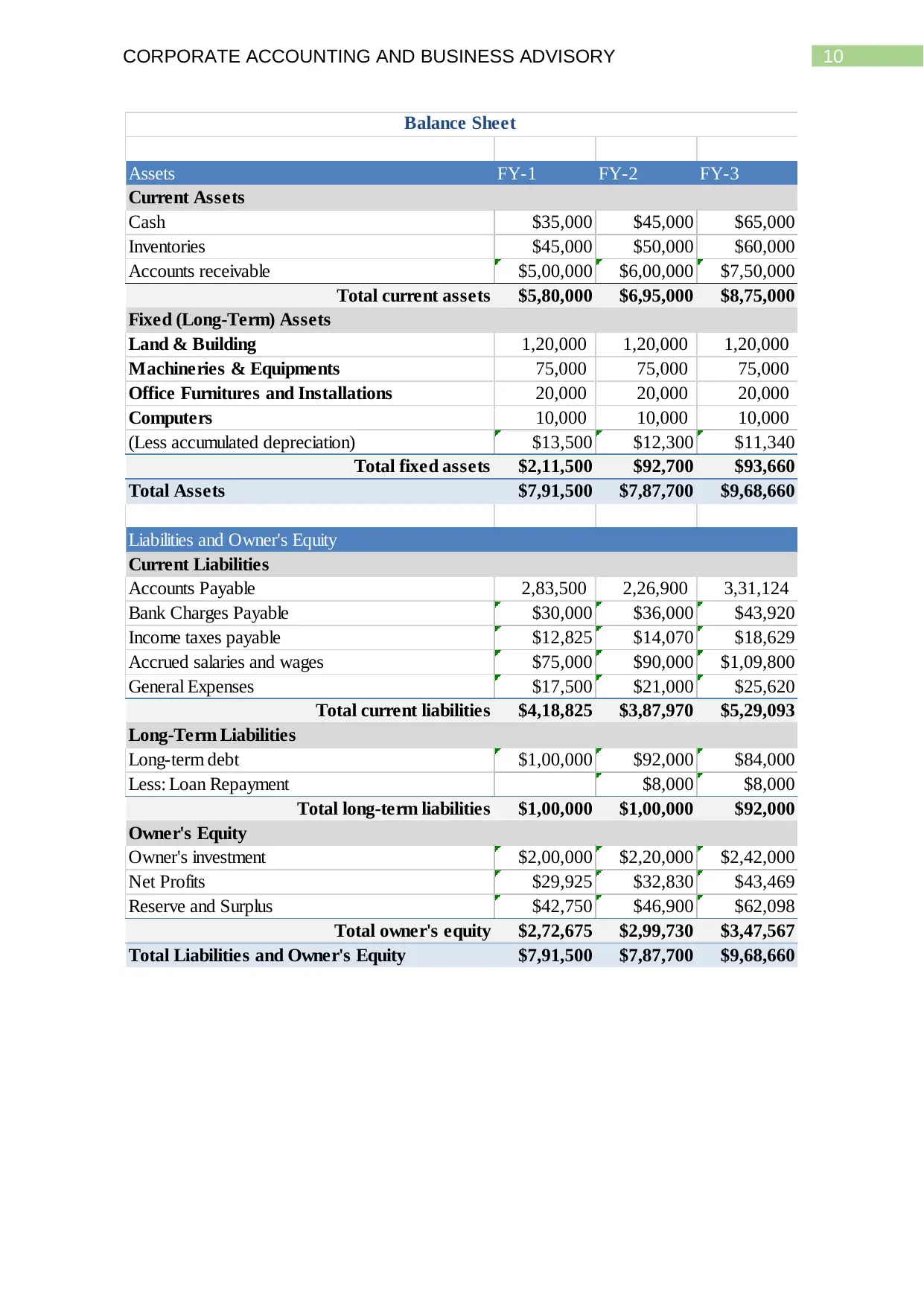
10CORPORATE ACCOUNTING AND BUSINESS ADVISORY
Assets FY-1 FY-2 FY-3
Current Assets
Cash $35,000 $45,000 $65,000
Inventories $45,000 $50,000 $60,000
Accounts receivable $5,00,000 $6,00,000 $7,50,000
Total current assets $5,80,000 $6,95,000 $8,75,000
Fixed (Long-Term) Assets
Land & Building 1,20,000 1,20,000 1,20,000
Machineries & Equipments 75,000 75,000 75,000
Office Furnitures and Installations 20,000 20,000 20,000
Computers 10,000 10,000 10,000
(Less accumulated depreciation) $13,500 $12,300 $11,340
Total fixed assets $2,11,500 $92,700 $93,660
Total Assets $7,91,500 $7,87,700 $9,68,660
Liabilities and Owner's Equity
Current Liabilities
Accounts Payable 2,83,500 2,26,900 3,31,124
Bank Charges Payable $30,000 $36,000 $43,920
Income taxes payable $12,825 $14,070 $18,629
Accrued salaries and wages $75,000 $90,000 $1,09,800
General Expenses $17,500 $21,000 $25,620
Total current liabilities $4,18,825 $3,87,970 $5,29,093
Long-Term Liabilities
Long-term debt $1,00,000 $92,000 $84,000
Less: Loan Repayment $8,000 $8,000
Total long-term liabilities $1,00,000 $1,00,000 $92,000
Owner's Equity
Owner's investment $2,00,000 $2,20,000 $2,42,000
Net Profits $29,925 $32,830 $43,469
Reserve and Surplus $42,750 $46,900 $62,098
Total owner's equity $2,72,675 $2,99,730 $3,47,567
Total Liabilities and Owner's Equity $7,91,500 $7,87,700 $9,68,660
Balance Sheet
Assets FY-1 FY-2 FY-3
Current Assets
Cash $35,000 $45,000 $65,000
Inventories $45,000 $50,000 $60,000
Accounts receivable $5,00,000 $6,00,000 $7,50,000
Total current assets $5,80,000 $6,95,000 $8,75,000
Fixed (Long-Term) Assets
Land & Building 1,20,000 1,20,000 1,20,000
Machineries & Equipments 75,000 75,000 75,000
Office Furnitures and Installations 20,000 20,000 20,000
Computers 10,000 10,000 10,000
(Less accumulated depreciation) $13,500 $12,300 $11,340
Total fixed assets $2,11,500 $92,700 $93,660
Total Assets $7,91,500 $7,87,700 $9,68,660
Liabilities and Owner's Equity
Current Liabilities
Accounts Payable 2,83,500 2,26,900 3,31,124
Bank Charges Payable $30,000 $36,000 $43,920
Income taxes payable $12,825 $14,070 $18,629
Accrued salaries and wages $75,000 $90,000 $1,09,800
General Expenses $17,500 $21,000 $25,620
Total current liabilities $4,18,825 $3,87,970 $5,29,093
Long-Term Liabilities
Long-term debt $1,00,000 $92,000 $84,000
Less: Loan Repayment $8,000 $8,000
Total long-term liabilities $1,00,000 $1,00,000 $92,000
Owner's Equity
Owner's investment $2,00,000 $2,20,000 $2,42,000
Net Profits $29,925 $32,830 $43,469
Reserve and Surplus $42,750 $46,900 $62,098
Total owner's equity $2,72,675 $2,99,730 $3,47,567
Total Liabilities and Owner's Equity $7,91,500 $7,87,700 $9,68,660
Balance Sheet
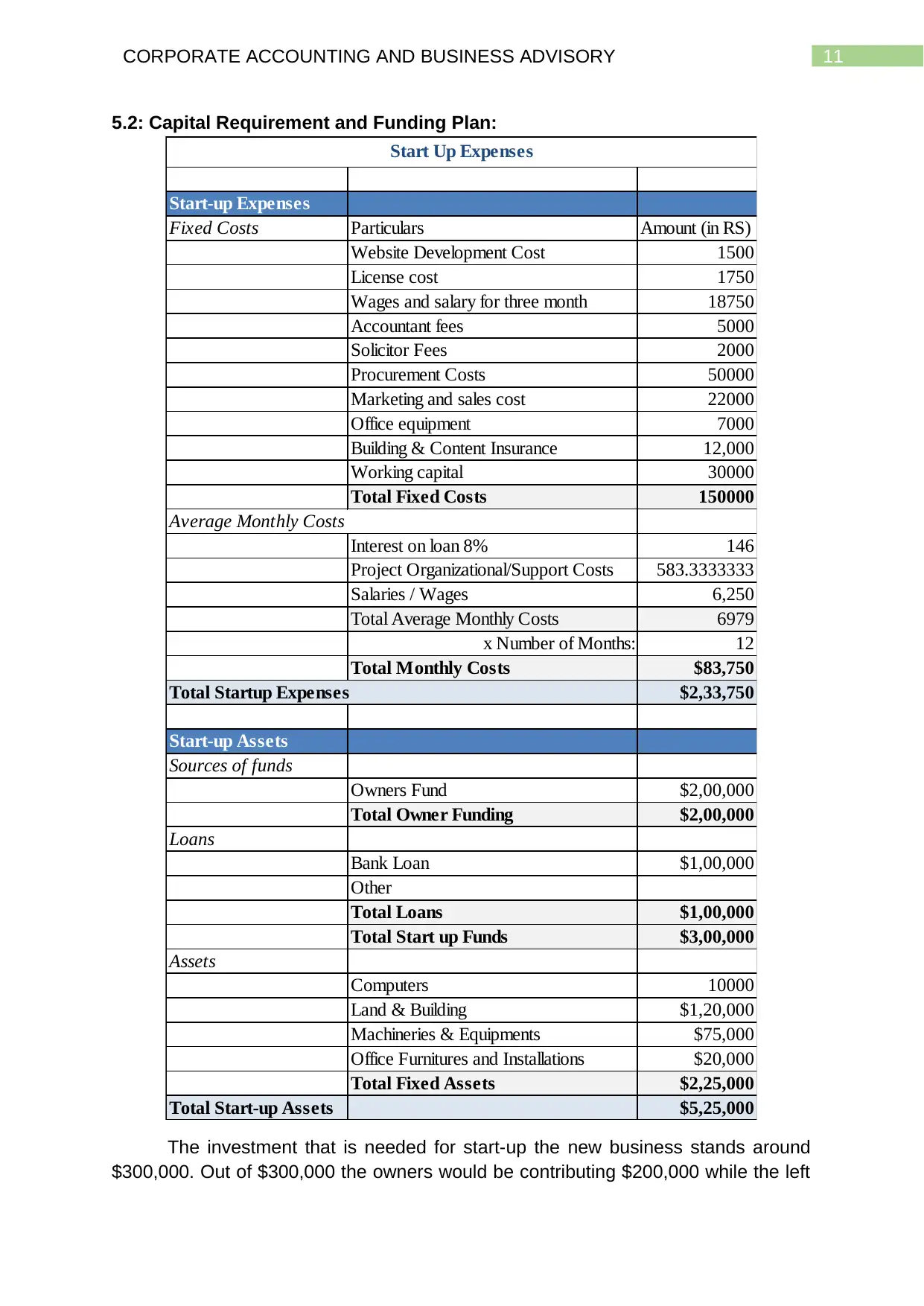
11CORPORATE ACCOUNTING AND BUSINESS ADVISORY
5.2: Capital Requirement and Funding Plan:
Start-up Expenses
Fixed Costs Particulars Amount (in RS)
Website Development Cost 1500
License cost 1750
Wages and salary for three month 18750
Accountant fees 5000
Solicitor Fees 2000
Procurement Costs 50000
Marketing and sales cost 22000
Office equipment 7000
Building & Content Insurance 12,000
Working capital 30000
Total Fixed Costs 150000
Average Monthly Costs
Interest on loan 8% 146
Project Organizational/Support Costs 583.3333333
Salaries / Wages 6,250
Total Average Monthly Costs 6979
x Number of Months: 12
Total Monthly Costs $83,750
Total Startup Expenses $2,33,750
Start-up Assets
Sources of funds
Owners Fund $2,00,000
Total Owner Funding $2,00,000
Loans
Bank Loan $1,00,000
Other
Total Loans $1,00,000
Total Start up Funds $3,00,000
Assets
Computers 10000
Land & Building $1,20,000
Machineries & Equipments $75,000
Office Furnitures and Installations $20,000
Total Fixed Assets $2,25,000
Total Start-up Assets $5,25,000
Start Up Expenses
The investment that is needed for start-up the new business stands around
$300,000. Out of $300,000 the owners would be contributing $200,000 while the left
5.2: Capital Requirement and Funding Plan:
Start-up Expenses
Fixed Costs Particulars Amount (in RS)
Website Development Cost 1500
License cost 1750
Wages and salary for three month 18750
Accountant fees 5000
Solicitor Fees 2000
Procurement Costs 50000
Marketing and sales cost 22000
Office equipment 7000
Building & Content Insurance 12,000
Working capital 30000
Total Fixed Costs 150000
Average Monthly Costs
Interest on loan 8% 146
Project Organizational/Support Costs 583.3333333
Salaries / Wages 6,250
Total Average Monthly Costs 6979
x Number of Months: 12
Total Monthly Costs $83,750
Total Startup Expenses $2,33,750
Start-up Assets
Sources of funds
Owners Fund $2,00,000
Total Owner Funding $2,00,000
Loans
Bank Loan $1,00,000
Other
Total Loans $1,00,000
Total Start up Funds $3,00,000
Assets
Computers 10000
Land & Building $1,20,000
Machineries & Equipments $75,000
Office Furnitures and Installations $20,000
Total Fixed Assets $2,25,000
Total Start-up Assets $5,25,000
Start Up Expenses
The investment that is needed for start-up the new business stands around
$300,000. Out of $300,000 the owners would be contributing $200,000 while the left
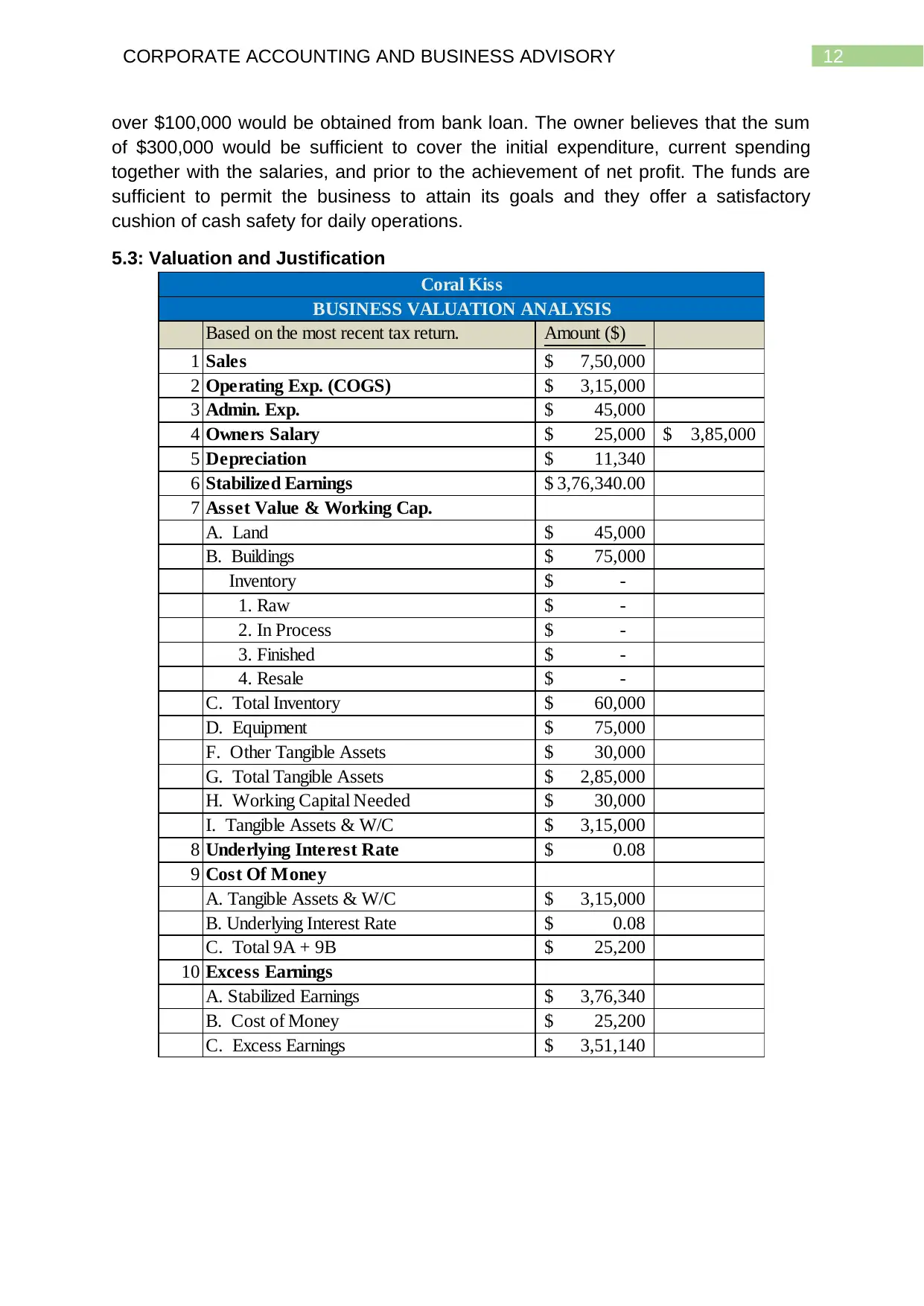
12CORPORATE ACCOUNTING AND BUSINESS ADVISORY
over $100,000 would be obtained from bank loan. The owner believes that the sum
of $300,000 would be sufficient to cover the initial expenditure, current spending
together with the salaries, and prior to the achievement of net profit. The funds are
sufficient to permit the business to attain its goals and they offer a satisfactory
cushion of cash safety for daily operations.
5.3: Valuation and Justification
Based on the most recent tax return. Amount ($)
1 Sales 7,50,000$
2 Operating Exp. (COGS) 3,15,000$
3 Admin. Exp. 45,000$
4 Owners Salary 25,000$ 3,85,000$
5 Depreciation 11,340$
6 Stabilized Earnings 3,76,340.00$
7 Asset Value & Working Cap.
A. Land 45,000$
B. Buildings 75,000$
Inventory -$
1. Raw -$
2. In Process -$
3. Finished -$
4. Resale -$
C. Total Inventory 60,000$
D. Equipment 75,000$
F. Other Tangible Assets 30,000$
G. Total Tangible Assets 2,85,000$
H. Working Capital Needed 30,000$
I. Tangible Assets & W/C 3,15,000$
8 Underlying Interest Rate 0.08$
9 Cost Of Money
A. Tangible Assets & W/C 3,15,000$
B. Underlying Interest Rate 0.08$
C. Total 9A + 9B 25,200$
10 Excess Earnings
A. Stabilized Earnings 3,76,340$
B. Cost of Money 25,200$
C. Excess Earnings 3,51,140$
Coral Kiss
BUSINESS VALUATION ANALYSIS
over $100,000 would be obtained from bank loan. The owner believes that the sum
of $300,000 would be sufficient to cover the initial expenditure, current spending
together with the salaries, and prior to the achievement of net profit. The funds are
sufficient to permit the business to attain its goals and they offer a satisfactory
cushion of cash safety for daily operations.
5.3: Valuation and Justification
Based on the most recent tax return. Amount ($)
1 Sales 7,50,000$
2 Operating Exp. (COGS) 3,15,000$
3 Admin. Exp. 45,000$
4 Owners Salary 25,000$ 3,85,000$
5 Depreciation 11,340$
6 Stabilized Earnings 3,76,340.00$
7 Asset Value & Working Cap.
A. Land 45,000$
B. Buildings 75,000$
Inventory -$
1. Raw -$
2. In Process -$
3. Finished -$
4. Resale -$
C. Total Inventory 60,000$
D. Equipment 75,000$
F. Other Tangible Assets 30,000$
G. Total Tangible Assets 2,85,000$
H. Working Capital Needed 30,000$
I. Tangible Assets & W/C 3,15,000$
8 Underlying Interest Rate 0.08$
9 Cost Of Money
A. Tangible Assets & W/C 3,15,000$
B. Underlying Interest Rate 0.08$
C. Total 9A + 9B 25,200$
10 Excess Earnings
A. Stabilized Earnings 3,76,340$
B. Cost of Money 25,200$
C. Excess Earnings 3,51,140$
Coral Kiss
BUSINESS VALUATION ANALYSIS
Paraphrase This Document
Need a fresh take? Get an instant paraphrase of this document with our AI Paraphraser
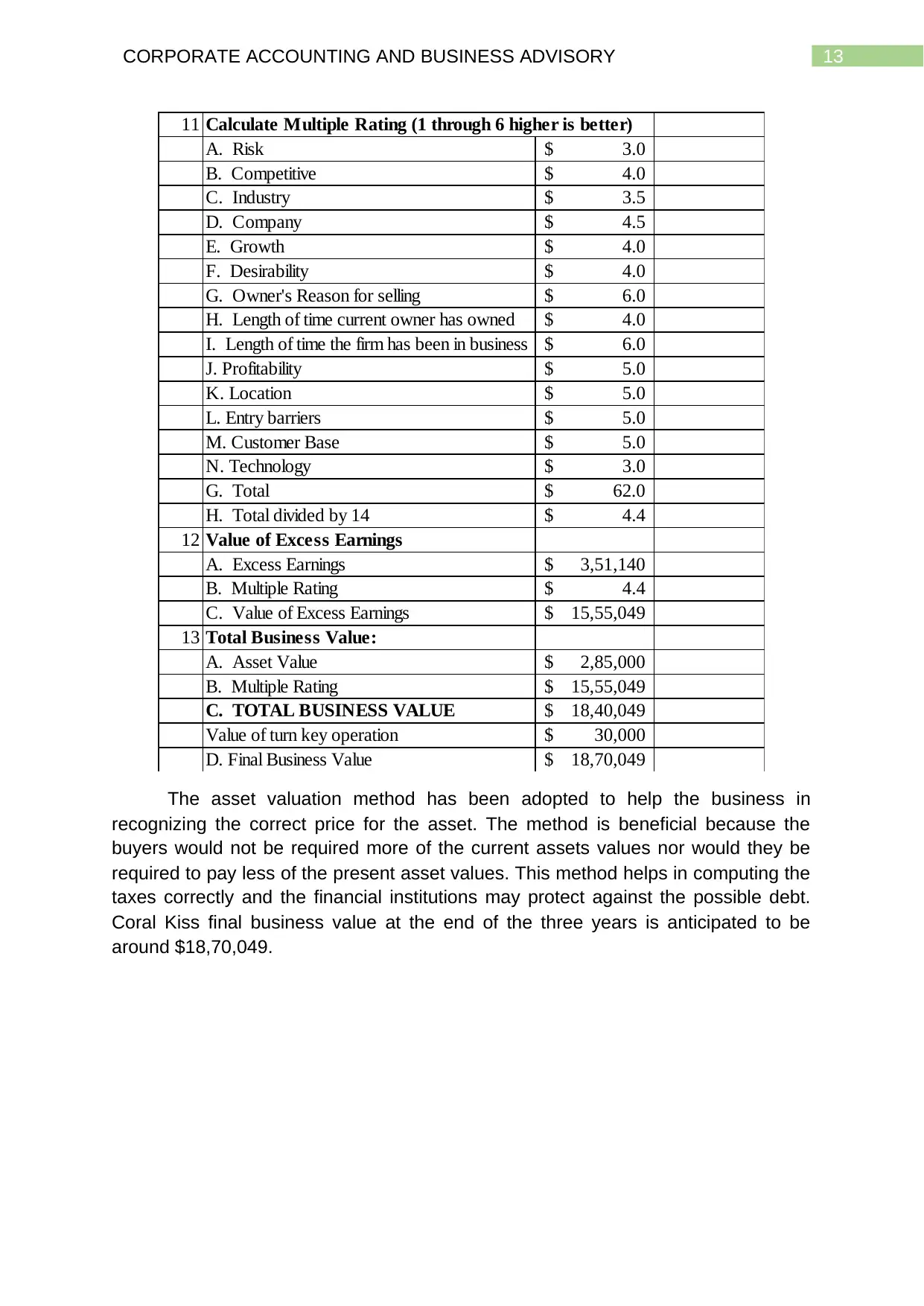
13CORPORATE ACCOUNTING AND BUSINESS ADVISORY
11 Calculate Multiple Rating (1 through 6 higher is better)
A. Risk 3.0$
B. Competitive 4.0$
C. Industry 3.5$
D. Company 4.5$
E. Growth 4.0$
F. Desirability 4.0$
G. Owner's Reason for selling 6.0$
H. Length of time current owner has owned 4.0$
I. Length of time the firm has been in business 6.0$
J. Profitability 5.0$
K. Location 5.0$
L. Entry barriers 5.0$
M. Customer Base 5.0$
N. Technology 3.0$
G. Total 62.0$
H. Total divided by 14 4.4$
12 Value of Excess Earnings
A. Excess Earnings 3,51,140$
B. Multiple Rating 4.4$
C. Value of Excess Earnings 15,55,049$
13 Total Business Value:
A. Asset Value 2,85,000$
B. Multiple Rating 15,55,049$
C. TOTAL BUSINESS VALUE 18,40,049$
Value of turn key operation 30,000$
D. Final Business Value 18,70,049$
The asset valuation method has been adopted to help the business in
recognizing the correct price for the asset. The method is beneficial because the
buyers would not be required more of the current assets values nor would they be
required to pay less of the present asset values. This method helps in computing the
taxes correctly and the financial institutions may protect against the possible debt.
Coral Kiss final business value at the end of the three years is anticipated to be
around $18,70,049.
11 Calculate Multiple Rating (1 through 6 higher is better)
A. Risk 3.0$
B. Competitive 4.0$
C. Industry 3.5$
D. Company 4.5$
E. Growth 4.0$
F. Desirability 4.0$
G. Owner's Reason for selling 6.0$
H. Length of time current owner has owned 4.0$
I. Length of time the firm has been in business 6.0$
J. Profitability 5.0$
K. Location 5.0$
L. Entry barriers 5.0$
M. Customer Base 5.0$
N. Technology 3.0$
G. Total 62.0$
H. Total divided by 14 4.4$
12 Value of Excess Earnings
A. Excess Earnings 3,51,140$
B. Multiple Rating 4.4$
C. Value of Excess Earnings 15,55,049$
13 Total Business Value:
A. Asset Value 2,85,000$
B. Multiple Rating 15,55,049$
C. TOTAL BUSINESS VALUE 18,40,049$
Value of turn key operation 30,000$
D. Final Business Value 18,70,049$
The asset valuation method has been adopted to help the business in
recognizing the correct price for the asset. The method is beneficial because the
buyers would not be required more of the current assets values nor would they be
required to pay less of the present asset values. This method helps in computing the
taxes correctly and the financial institutions may protect against the possible debt.
Coral Kiss final business value at the end of the three years is anticipated to be
around $18,70,049.
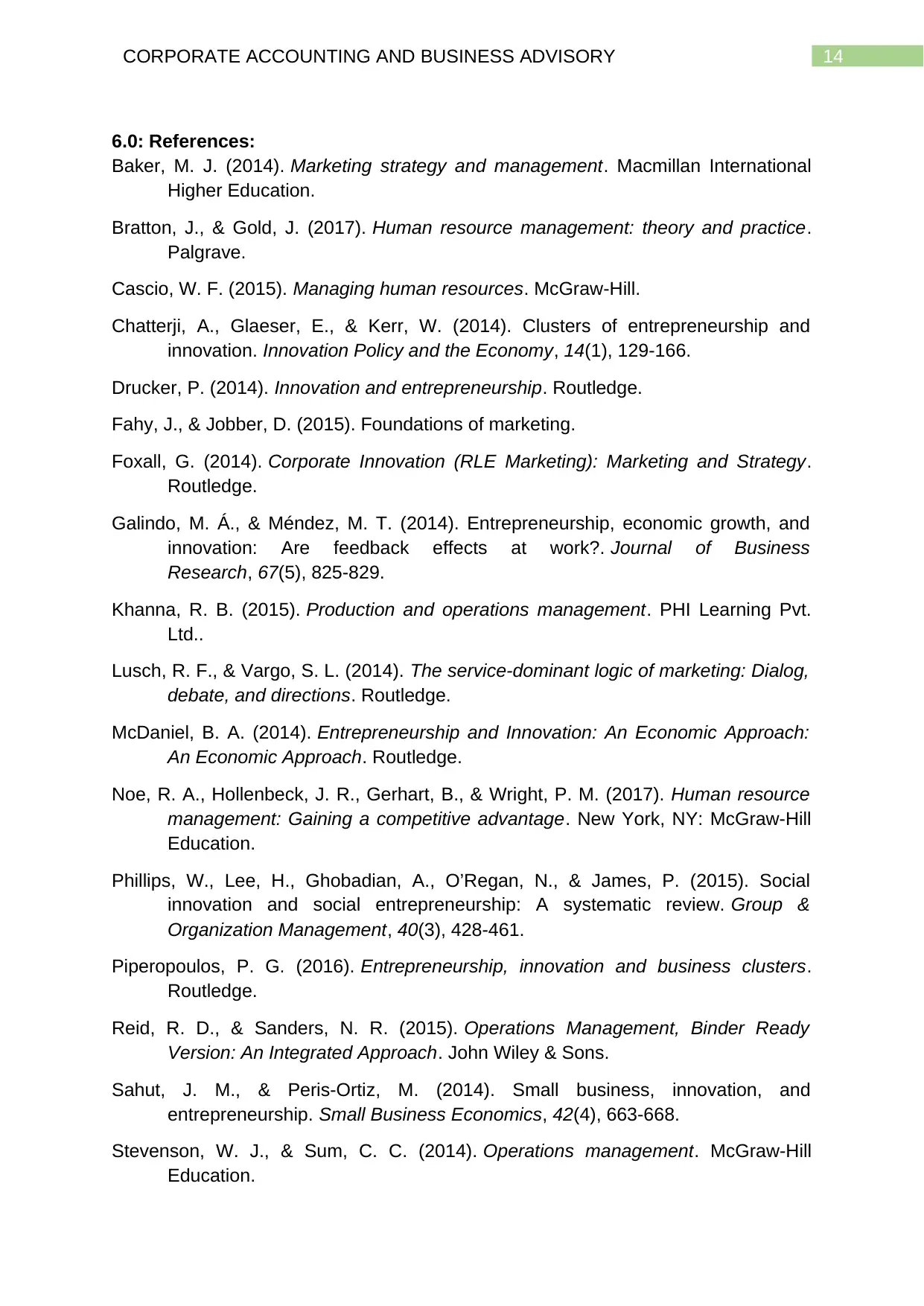
14CORPORATE ACCOUNTING AND BUSINESS ADVISORY
6.0: References:
Baker, M. J. (2014). Marketing strategy and management. Macmillan International
Higher Education.
Bratton, J., & Gold, J. (2017). Human resource management: theory and practice.
Palgrave.
Cascio, W. F. (2015). Managing human resources. McGraw-Hill.
Chatterji, A., Glaeser, E., & Kerr, W. (2014). Clusters of entrepreneurship and
innovation. Innovation Policy and the Economy, 14(1), 129-166.
Drucker, P. (2014). Innovation and entrepreneurship. Routledge.
Fahy, J., & Jobber, D. (2015). Foundations of marketing.
Foxall, G. (2014). Corporate Innovation (RLE Marketing): Marketing and Strategy.
Routledge.
Galindo, M. Á., & Méndez, M. T. (2014). Entrepreneurship, economic growth, and
innovation: Are feedback effects at work?. Journal of Business
Research, 67(5), 825-829.
Khanna, R. B. (2015). Production and operations management. PHI Learning Pvt.
Ltd..
Lusch, R. F., & Vargo, S. L. (2014). The service-dominant logic of marketing: Dialog,
debate, and directions. Routledge.
McDaniel, B. A. (2014). Entrepreneurship and Innovation: An Economic Approach:
An Economic Approach. Routledge.
Noe, R. A., Hollenbeck, J. R., Gerhart, B., & Wright, P. M. (2017). Human resource
management: Gaining a competitive advantage. New York, NY: McGraw-Hill
Education.
Phillips, W., Lee, H., Ghobadian, A., O’Regan, N., & James, P. (2015). Social
innovation and social entrepreneurship: A systematic review. Group &
Organization Management, 40(3), 428-461.
Piperopoulos, P. G. (2016). Entrepreneurship, innovation and business clusters.
Routledge.
Reid, R. D., & Sanders, N. R. (2015). Operations Management, Binder Ready
Version: An Integrated Approach. John Wiley & Sons.
Sahut, J. M., & Peris-Ortiz, M. (2014). Small business, innovation, and
entrepreneurship. Small Business Economics, 42(4), 663-668.
Stevenson, W. J., & Sum, C. C. (2014). Operations management. McGraw-Hill
Education.
6.0: References:
Baker, M. J. (2014). Marketing strategy and management. Macmillan International
Higher Education.
Bratton, J., & Gold, J. (2017). Human resource management: theory and practice.
Palgrave.
Cascio, W. F. (2015). Managing human resources. McGraw-Hill.
Chatterji, A., Glaeser, E., & Kerr, W. (2014). Clusters of entrepreneurship and
innovation. Innovation Policy and the Economy, 14(1), 129-166.
Drucker, P. (2014). Innovation and entrepreneurship. Routledge.
Fahy, J., & Jobber, D. (2015). Foundations of marketing.
Foxall, G. (2014). Corporate Innovation (RLE Marketing): Marketing and Strategy.
Routledge.
Galindo, M. Á., & Méndez, M. T. (2014). Entrepreneurship, economic growth, and
innovation: Are feedback effects at work?. Journal of Business
Research, 67(5), 825-829.
Khanna, R. B. (2015). Production and operations management. PHI Learning Pvt.
Ltd..
Lusch, R. F., & Vargo, S. L. (2014). The service-dominant logic of marketing: Dialog,
debate, and directions. Routledge.
McDaniel, B. A. (2014). Entrepreneurship and Innovation: An Economic Approach:
An Economic Approach. Routledge.
Noe, R. A., Hollenbeck, J. R., Gerhart, B., & Wright, P. M. (2017). Human resource
management: Gaining a competitive advantage. New York, NY: McGraw-Hill
Education.
Phillips, W., Lee, H., Ghobadian, A., O’Regan, N., & James, P. (2015). Social
innovation and social entrepreneurship: A systematic review. Group &
Organization Management, 40(3), 428-461.
Piperopoulos, P. G. (2016). Entrepreneurship, innovation and business clusters.
Routledge.
Reid, R. D., & Sanders, N. R. (2015). Operations Management, Binder Ready
Version: An Integrated Approach. John Wiley & Sons.
Sahut, J. M., & Peris-Ortiz, M. (2014). Small business, innovation, and
entrepreneurship. Small Business Economics, 42(4), 663-668.
Stevenson, W. J., & Sum, C. C. (2014). Operations management. McGraw-Hill
Education.
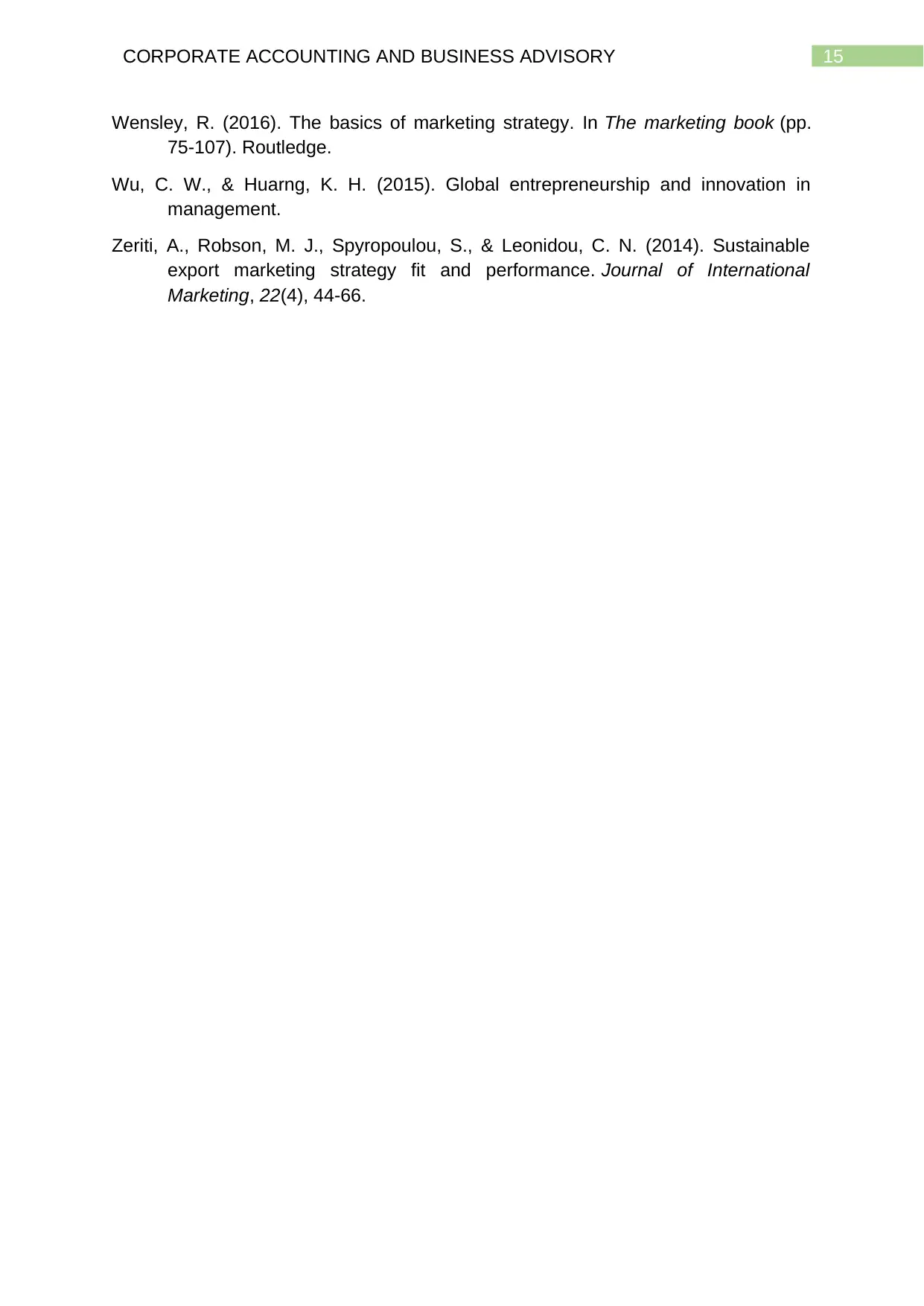
15CORPORATE ACCOUNTING AND BUSINESS ADVISORY
Wensley, R. (2016). The basics of marketing strategy. In The marketing book (pp.
75-107). Routledge.
Wu, C. W., & Huarng, K. H. (2015). Global entrepreneurship and innovation in
management.
Zeriti, A., Robson, M. J., Spyropoulou, S., & Leonidou, C. N. (2014). Sustainable
export marketing strategy fit and performance. Journal of International
Marketing, 22(4), 44-66.
Wensley, R. (2016). The basics of marketing strategy. In The marketing book (pp.
75-107). Routledge.
Wu, C. W., & Huarng, K. H. (2015). Global entrepreneurship and innovation in
management.
Zeriti, A., Robson, M. J., Spyropoulou, S., & Leonidou, C. N. (2014). Sustainable
export marketing strategy fit and performance. Journal of International
Marketing, 22(4), 44-66.
1 out of 16
Related Documents
Your All-in-One AI-Powered Toolkit for Academic Success.
+13062052269
info@desklib.com
Available 24*7 on WhatsApp / Email
![[object Object]](/_next/static/media/star-bottom.7253800d.svg)
Unlock your academic potential
© 2024 | Zucol Services PVT LTD | All rights reserved.





